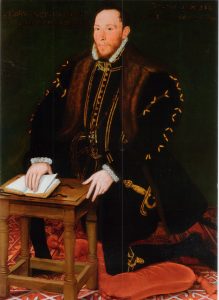Challenges to Elizabethan Religious Settlement
Challenges to Elizabethan Religious Settlement came from several places. As the settlement was middle ground it did not satisfy more ardent supporters of some religious movements. In particular there was opposition from Puritan and Roman Catholic worshippers. The Religious Settlement offended some members of the nobility, leading to the Northern Rebellion. It also increased tension with foreign powers, many of whom were Catholic and wary of any state that became protestant.
The Puritan Challenge
Puritans believed that worship and prayer should be plain and simple. Churches and the ministers ought to reflect the work the Jesus did in helping the poor. Instead of being full of expensive statues, paintings and elaborate religious icons and items, the church should be plain, simple and focused upon piety and prayer. Worship should reflect the suffering of Jesus and his teachings. This should include periods of fasting, alms giving and suchlike.
The Religious Settlement did not enforce the Puritan view of church layout, decorations or the dress of preachers. The main areas that puritans disagreed with were the allowance of crucifixes and vestments.
The crucifix shows Jesus dying on the cross. For many it is an important religious symbol. For puritans, it was an icon and as such ought not to be permitted. Elizabeth wanted the crucifix to be included in all churches. It would go some way towards getting Roman Catholics to support her settlement. However, Puritan bishops threatened to resign if the crucifix was imposed. Due to the number of bishops and the lack of suitable replacements, Elizabeth had to remove the imposition of the crucifix from the Settlement.
Vestments are special clothes worn by priests. They signify different types of mass and are illustrative of gods will and ongoing work. Puritans did not believe that a priest should wear vestments. They thought that they were too elaborate. Priests were preachers, not gods appointee. Vestments were therefore a way of making an ordinary person appear to be more important than others. It was a way of turning the priest into a form of idol. The settlement had disagreed with that. It insisted on vestments as the priest was, to most worshippers, the vessel through which water and wine was turned into Holy Communion during the service. The vestments made the importance of this role very clear.
Puritans simply refused to comply with the Religious Settlement. They refused to wear vestments. By 1566 it was so clear that the Puritans were refusing to comply that exhibitions were held to show priests and bishops what type of vestment were permitted: not all are really elaborate. Many puritans attending the exhibition refused to use any of the vestments. They were removed from their posts.

Roman Catholic Challenge to the Religious Settlement
Across Europe the Papacy was engaged in persecuting protestants and was in the midst of a counter-reformation. It was clear that the Pope and Roman Catholic Church leadership would not sanction anything other than full Roman Catholicism. Despite this, little of note happened in terms of open opposition to the Religious Settlement in the first few years. The Settlement had enabled Catholics some methods of staying true to their own ways and evidence suggests that the majority complied with most of the settlement, most of the time.
The main opposition initially came from the Northern Earls. The Earls of Westmoreland and Northumberland were both Roman Catholic. They had both had a lot of power under Mary I which was greatly diminished under Elizabeth’s rule. See Society and Government in 1558 for the structure they were excluded from.
It wasn’t until 1569 that any major opposition from Roman Catholics occurred. Westmoreland and Northumberland rose up in revolt. The seized Durham Cathedral and celebrated a full Catholic mass. They then marched south. They were joined by many Catholics which suggests that there was dissatisfaction at the Settlement. However, most of the other Catholic nobles remained loyal to the Queen. The notable exception was the Queen’s cousin, the Duke of Norfolk who sided with the rebels.
The rebellion was put down by the Queens army. Many of the rebels were executed in a public show of the might of the crown. This not only deterred further rebellion but also made relations between Roman Catholics and Protestants more tense.
The Catholic challenge to the Settlement was in part fuelled by the position of Mary, Queen of Scots. With a legitimate Catholic heir to the throne they had reason to believe that Catholicism would return and some were inclined to plot or continue Catholic ways based on this.
Conclusions: Challenges to the Elizabethan Settlement
The Elizabethan Settlement was designed to appease as many people as possible. It incorporated elements of services that would be acceptable to Roman Catholics whilst maintaining many of the new ideas about prayer and worship. The Settlement did work in many ways. It allowed people to practise their religion with an element of flexibility. However the plots and challenges from traditionalist Catholics and extreme puritans meant that there was a crack down on worshipping practise. The actions of a relatively small number of people and the involvement of radical puritans and Papist missionaries and Jesuits meant that the freedoms that the freedoms that were initially in place were reduced and restricted. Tolerance however was improved.
Links: British History – The Tudors (KS2) – Elizabethan Era
Tutor2U – The Puritan Vestment Challenge
HistoryLearningSite – 1559 Religion Settlement
History of Parliament – Religious Debates in Elizabethan Parliaments

